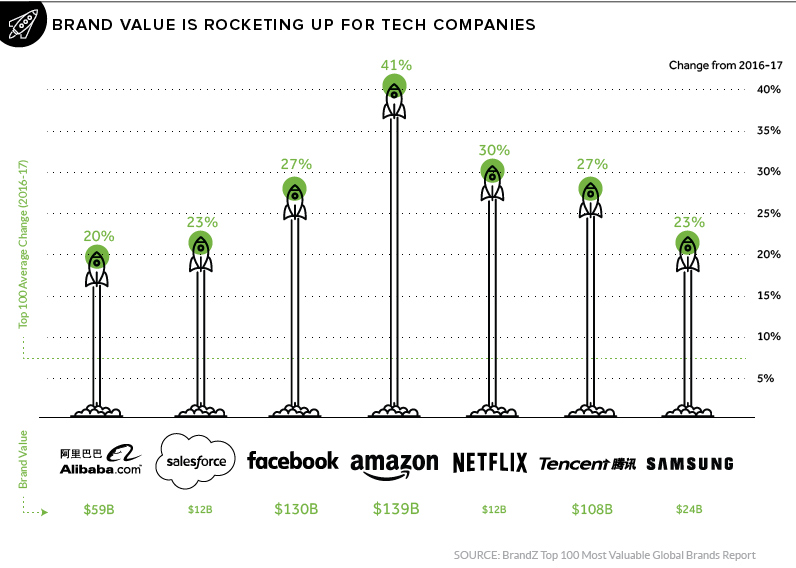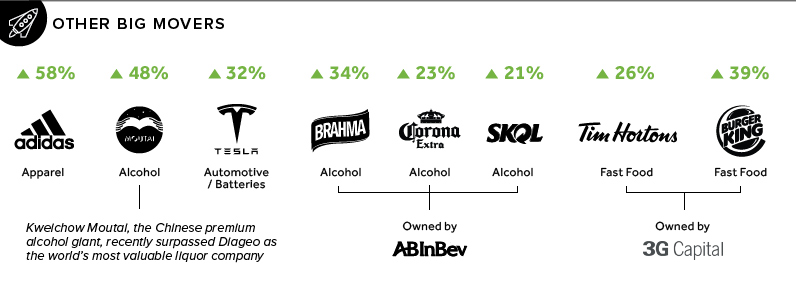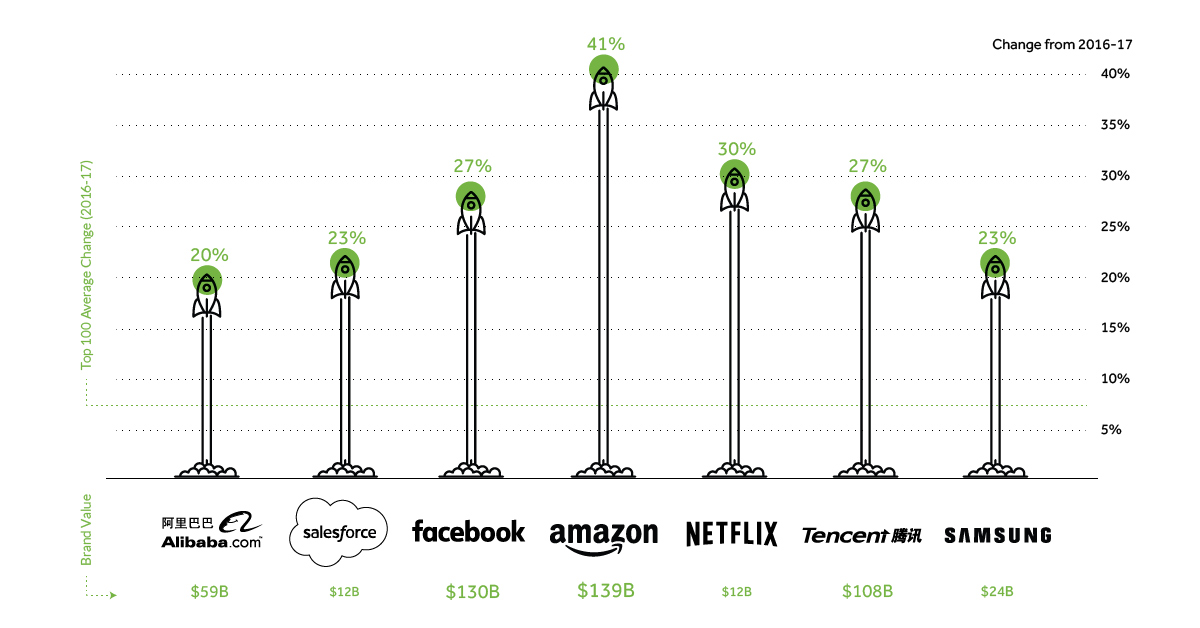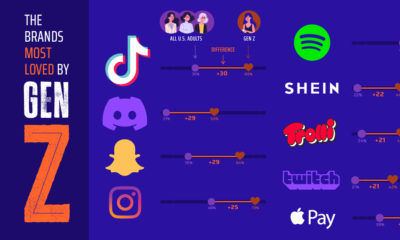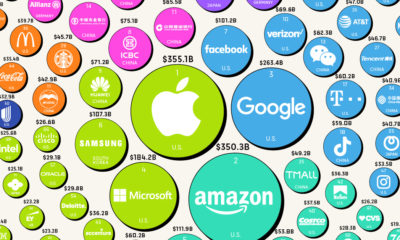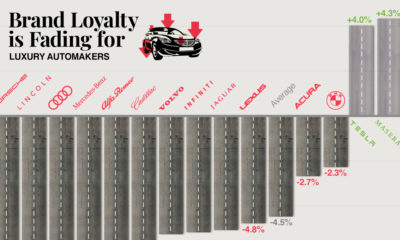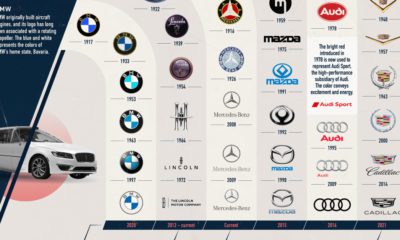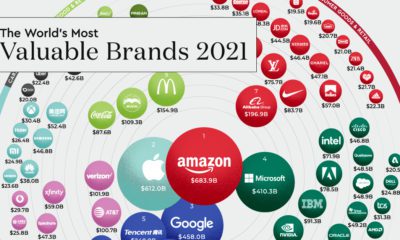In a modern business era of near-constant disruption, which brands are winning the hearts of consumers the fastest? Today’s charts look at the brands that are trending upwards. See below for the brands that have gained the most in brand value since last year, as assessed by BrandZ in their report on the world’s 100 most valuable brands.
Onwards and Upwards for Tech
As many big name brands try to find their footing in today’s fast-paced consumer environment, it’s not surprising to see up-and-coming tech brands skyrocketing in value.
Note: the measure of “brand value”, not to be confused with company valuation metrics like market cap, is a way of quantifying the dollar value that a particular brand’s image is contributing to the overall value of a corporation.
Other Big Movers
Although tech brands seem to be moving up the list in unison, it’s also worth examining the brands in other sectors that have seen their brand values rapidly increase.
The brands seen here have some interesting commonalities and points worth noting. Firstly, despite not being a tech brand, Adidas was actually the fastest-growing brand in the whole report with a 58% increase in brand value from 2016 to 2017. According to the analysis, the apparel brand saw its retro sneakers “connect perfectly” with the fashion moment. Next, alcohol brands also generally performed admirably. Three of the brands that had double-digit growth were owned by the world’s largest beer company, AB InBev – and two of those brands (Skol and Brahma) are Brazilian. Further, Kweichow Moutai, a Chinese liquor maker that surpassed Diageo earlier this year in market capitalization, is also rising fast. Also of interest is that two 3G Capital restaurant brands, Burger King and Tim Horton’s, happened to increase substantially in brand value. Of course, 3G Capital owns a stake in the aforementioned AB InBev as well.
New Entrants
The following brands are the newest entrants on the 2017 edition of the top 100 list:
However, as we transition into 2018, these new entrants may have very different fortunes ahead of them. On one hand, Salesforce has been outlining when it’ll hit $20 billion in sales, and Netflix is still crushing expectations for subscription growth. On the opposite side of the spectrum, Snap Inc. recently reported slow user growth, which made shares tumble 18% in value. The company’s platform, Snapchat, is locked in a battle with Instagram for users, and it remains to be seen how this will affect both company and brand values down the road.
on But fast forward to the end of last week, and SVB was shuttered by regulators after a panic-induced bank run. So, how exactly did this happen? We dig in below.
Road to a Bank Run
SVB and its customers generally thrived during the low interest rate era, but as rates rose, SVB found itself more exposed to risk than a typical bank. Even so, at the end of 2022, the bank’s balance sheet showed no cause for alarm.
As well, the bank was viewed positively in a number of places. Most Wall Street analyst ratings were overwhelmingly positive on the bank’s stock, and Forbes had just added the bank to its Financial All-Stars list. Outward signs of trouble emerged on Wednesday, March 8th, when SVB surprised investors with news that the bank needed to raise more than $2 billion to shore up its balance sheet. The reaction from prominent venture capitalists was not positive, with Coatue Management, Union Square Ventures, and Peter Thiel’s Founders Fund moving to limit exposure to the 40-year-old bank. The influence of these firms is believed to have added fuel to the fire, and a bank run ensued. Also influencing decision making was the fact that SVB had the highest percentage of uninsured domestic deposits of all big banks. These totaled nearly $152 billion, or about 97% of all deposits. By the end of the day, customers had tried to withdraw $42 billion in deposits.
What Triggered the SVB Collapse?
While the collapse of SVB took place over the course of 44 hours, its roots trace back to the early pandemic years. In 2021, U.S. venture capital-backed companies raised a record $330 billion—double the amount seen in 2020. At the time, interest rates were at rock-bottom levels to help buoy the economy. Matt Levine sums up the situation well: “When interest rates are low everywhere, a dollar in 20 years is about as good as a dollar today, so a startup whose business model is “we will lose money for a decade building artificial intelligence, and then rake in lots of money in the far future” sounds pretty good. When interest rates are higher, a dollar today is better than a dollar tomorrow, so investors want cash flows. When interest rates were low for a long time, and suddenly become high, all the money that was rushing to your customers is suddenly cut off.” Source: Pitchbook Why is this important? During this time, SVB received billions of dollars from these venture-backed clients. In one year alone, their deposits increased 100%. They took these funds and invested them in longer-term bonds. As a result, this created a dangerous trap as the company expected rates would remain low. During this time, SVB invested in bonds at the top of the market. As interest rates rose higher and bond prices declined, SVB started taking major losses on their long-term bond holdings.
Losses Fueling a Liquidity Crunch
When SVB reported its fourth quarter results in early 2023, Moody’s Investor Service, a credit rating agency took notice. In early March, it said that SVB was at high risk for a downgrade due to its significant unrealized losses. In response, SVB looked to sell $2 billion of its investments at a loss to help boost liquidity for its struggling balance sheet. Soon, more hedge funds and venture investors realized SVB could be on thin ice. Depositors withdrew funds in droves, spurring a liquidity squeeze and prompting California regulators and the FDIC to step in and shut down the bank.
What Happens Now?
While much of SVB’s activity was focused on the tech sector, the bank’s shocking collapse has rattled a financial sector that is already on edge.
The four biggest U.S. banks lost a combined $52 billion the day before the SVB collapse. On Friday, other banking stocks saw double-digit drops, including Signature Bank (-23%), First Republic (-15%), and Silvergate Capital (-11%).
Source: Morningstar Direct. *Represents March 9 data, trading halted on March 10.
When the dust settles, it’s hard to predict the ripple effects that will emerge from this dramatic event. For investors, the Secretary of the Treasury Janet Yellen announced confidence in the banking system remaining resilient, noting that regulators have the proper tools in response to the issue.
But others have seen trouble brewing as far back as 2020 (or earlier) when commercial banking assets were skyrocketing and banks were buying bonds when rates were low.
